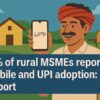V.P. Nandakumar, MD and CEO, Manappuram Finance, has set a target of 10 to 15% growth, even as the company has recorded a strong performance in portfolios other than gold loan
Mohan: Manappuram Finance had its gold loan business reach Rs 11,750 crore as on 31 March and you had set a target of 10% growth. Is the gold loan market poised for good growth in the country?

V.P. Nandakumar, MD and CEO, Manappuram Finance
V.P. Nandakumar: Yes, our gold loans portfolio stood at Rs11,750 crore as at the end of FY2018, which represents a 5.5% growth over the previous year. No doubt, growth was lower than what we had anticipated at the beginning of the year. But then, we also faced more than our fair share of challenges.
We cater predominantly to the unorganized sector which, as you know, bore the brunt of demonetization with the working capital cycle getting severely disrupted. The return to normality took longer than we expected and so, the first 2 quarters of the year saw little or no growth. It was only in the fourth quarter that growth really picked up.
With the rural economy expected to do well (given the expectations of a good monsoon and higher rural spending by the government) and gold prices holding firm, I do believe the gold loan market is poised for good growth across India. When I say good growth, I think something in the range of 10 to 15% should be achievable.
The company had diversified into microfinance business in a big way. Can you share details of growth of this business? Which are the states that you are focusing? Can you share details of the sectors to which you had extended finance?
We have diversified into microfinance in a big way along with home and vehicle loans, and some other areas as well. From a near total dependence on gold loans as recently as FY2014, we have now come to a position where the share of the new, non-gold businesses in our consolidated Assets under Management (AUM) exceeds 25%. The AUM of our microfinance subsidiary, Asirvad Microfinance, recorded a sharp increase of 36% during FY2018, growing to Rs 2,437 crore. When we acquired Asirvad in February 2015, its AUM was less than Rs300 crore. Today, Asirvad has 15 lakh customers, 832 branches and nearly 4,200 employees. It is present in 19 states and union undertakings and has become the 6th largest NBFC- MFI in the country.
Asirvad’s business is mainly focused on the southern states, which accounted for half of the total business in FY 2018. We are now focusing on expanding the microfinance business to new areas in the non-south geographies.
Can you also outline details of your housing finance, commercial vehicle finance and SME finance businesses?
Our commercial vehicle finance vertical has done very well, more than doubling its loan book, growing from Rs305 crore to Rs625 crore during the year. It operates from 73 locations and finances mainly used commercial vehicles and targets customers from the unorganized sector who lack access to formal banking channels.
Our home finance subsidiary operates from 35 branches and focuses on the affordable home segment. It has recorded a 20% growth in its loan book growing to Rs375 crore from Rs310 crore. The housing finance business targets the southern and westerns parts of the country. The SME finance business is still relatively small.
Where do you expect Manappuram Finance to be at the end of FY 2020 in terms of AUM, turnover and profits? What according to you would be the key drivers of growth?
We will continue to diversify our portfolio and will further explore opportunities to lend in other areas including niche areas where NBFCs are typically not present. In our ‘Vision 2020’ plan we have an ambitious target of growing our AUM to about Rs25,000 crore. We expect the gold loan business to grow by around 10% while looking at growing the consolidated book by about 20% for 2018-19.
As regards key growth drivers, we do foresee decent growth in gold loans, but the real impetus will come from our other businesses like microfinance, home finance and commercial vehicle loans riding on the strong recovery seen in the economy, especially rural economy.
In an earlier interaction with us, you had indicated that you would be undertaking an exercise to restructure your branch network, probably closing some branches in the south and opening new ones in the east and west. What is the status?
Restructuring of branch network is an ongoing process for us. For the last few years, we have maintained the number of our gold loan branches at about 3300 or so. What we have been doing is to close branches in saturated and unviable locations and shifting them to areas with greater potential.
We have traditionally had a very strong presence in south India but now, with saturation levels high in this part, we are gradually increasing our presence in the other parts of India. In FY2017, about 64% of our gold AUM came from south, which has come down to 60% in FY 2018.
Would you be interested in a banking license in your journey forward? Or would you be planning to align with a universal bank or the recently announced small finance banks to expand your footprint?
With the diversification of our portfolio gathering pace, we have already taken steps towards fulfilling the eligibility criteria for a universal bank license. However, we have not decided whether to apply for a banking license. That call will be taken by the board at the appropriate time.
As I mentioned earlier, our non-gold portfolio now accounts for 25.5% of our total loan book. As we continue scale up our lending under affordable home finance, micro finance and commercial vehicle finance, we will soon be able to meet the priority sector lending requirement applicable to banks. At that point, we will be better placed to take a call.
You have an online channel for gold loans. Can you share details of the business this channel could get? What has been the response? Which regions have responded well?
We launched our Online Gold Loan (OGL) product in late 2015 and since then it has picked up very well. The demonetization of high value currency notes in November 2016 also played a part in making the product more popular.
Our OGL portfolio has shown good growth this year. In fact, in the course of the year, it went up by 175% to touch nearly Rs3800 crore. As with conventional gold loans, the OGL segment is also currently more popular in the southern region which accounts for half of the portfolio, even as the share in other parts is increasing. The western region accounts for 20% followed by the east at 16% and the north at 14%. Last year, the southern region accounted for nearly 56% of the total OGL portfolio.
What are the plans on the anvil for digitization of your operations? Can you list the priority areas you have identified? Have you introduced eKYC?
At Manappuram, eKYC has been live in our branches for over a year. We are now developing an in-house eKYC solution. Other projects we are pursuing under digitization include one where we are working with leading solution providers to digitize paper work in the company. The focus is on customizing our existing ERP solution to achieve digitization. We are also getting all documents scanned – HR, legal, finance and administration – in a structured manner so as to achieve the goal of becoming a 100% paperless NBFC.
We will shortly undertake a process rationalization initiative wherein we will reengineer our existing processes to suit the BPM and DMS tools. On the branch operations side, we are testing an RPA (Robotic Process Automation) solution for the customer onboarding process. We are working on image processing software that can read off details from standard government documents like voter ID, PAN card etc so that process of filling loan application becomes easy. We also have done work on creating secure self-serve vaults that will reduce losses due to theft and robbery. Finally, we are working on many consumer-facing tools that will help create digitization of the loan processes right from the first step onwards.
Do you make use of analytics in a big way? If so, in which areas?
Yes, we have begun to apply analytics in all aspects of our businesses. For example, in loan sourcing, we are consistently optimizing our marketing budgets by looking at ROI from various channels. This is a fairly analytical exercise which requires benchmarking of response rates from each channel and then looking at the incremental lift that marketing spend is bringing. For cross-selling, we work with bureaus to develop surrogate variables for income and expenditure of our gold loan customers. Once we have this data, we should be able to apply advanced clustering techniques and affinity models. These methods will help us sell right product to right customers.
Coming to underwriting, as we look to grow our non-gold portfolio, we are increasingly shifting our focus to underwrite using score cards. We are working on collecting surrogate data by analyzing their bank statements, social media data. For portfolio risk monitoring, we are furthering our understanding of portfolio risk with early warning systems using default data and bounced cheques data. Once the system is in place, it will give our risk managers a full view of the future risk of our portfolio.







